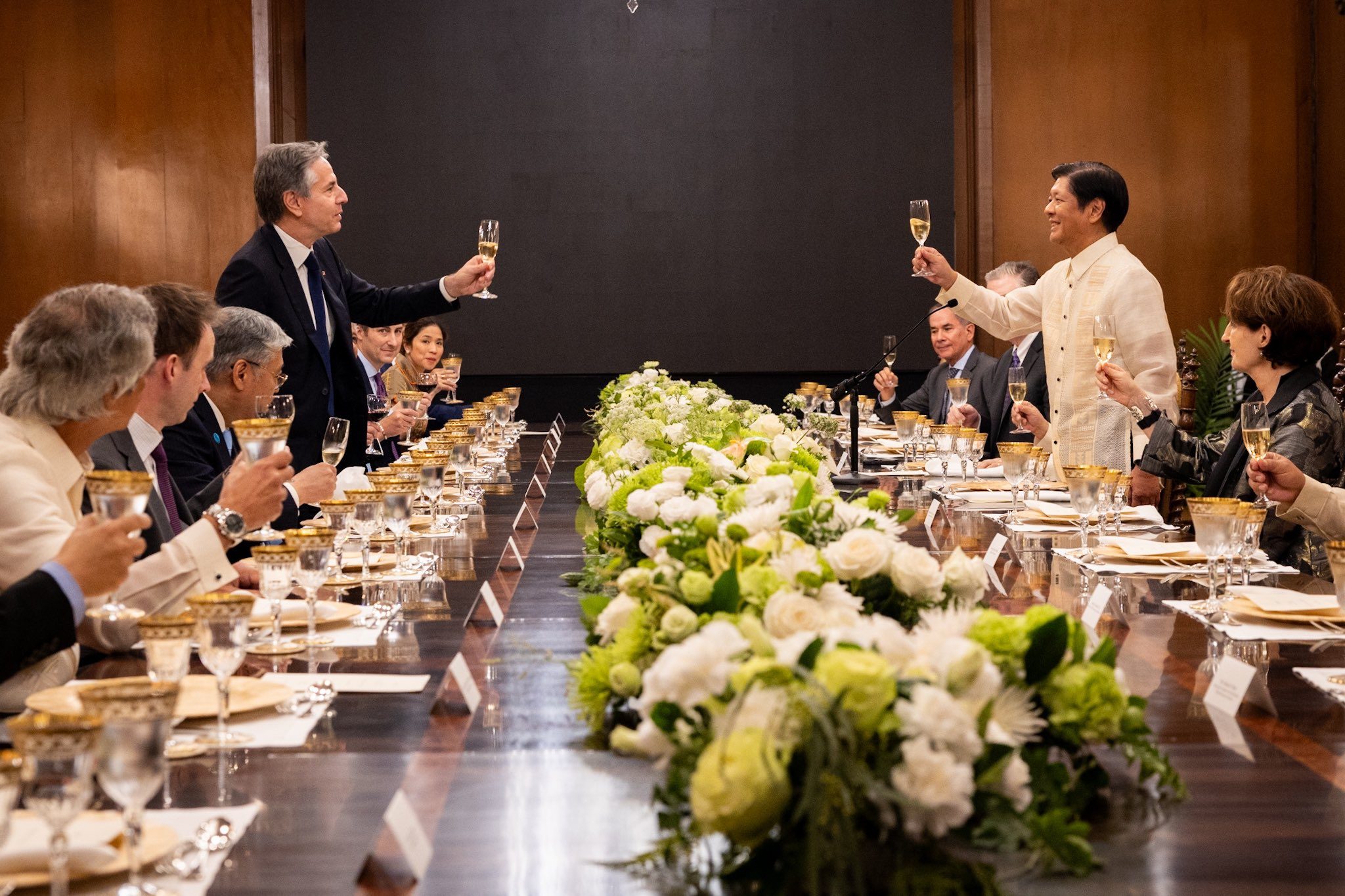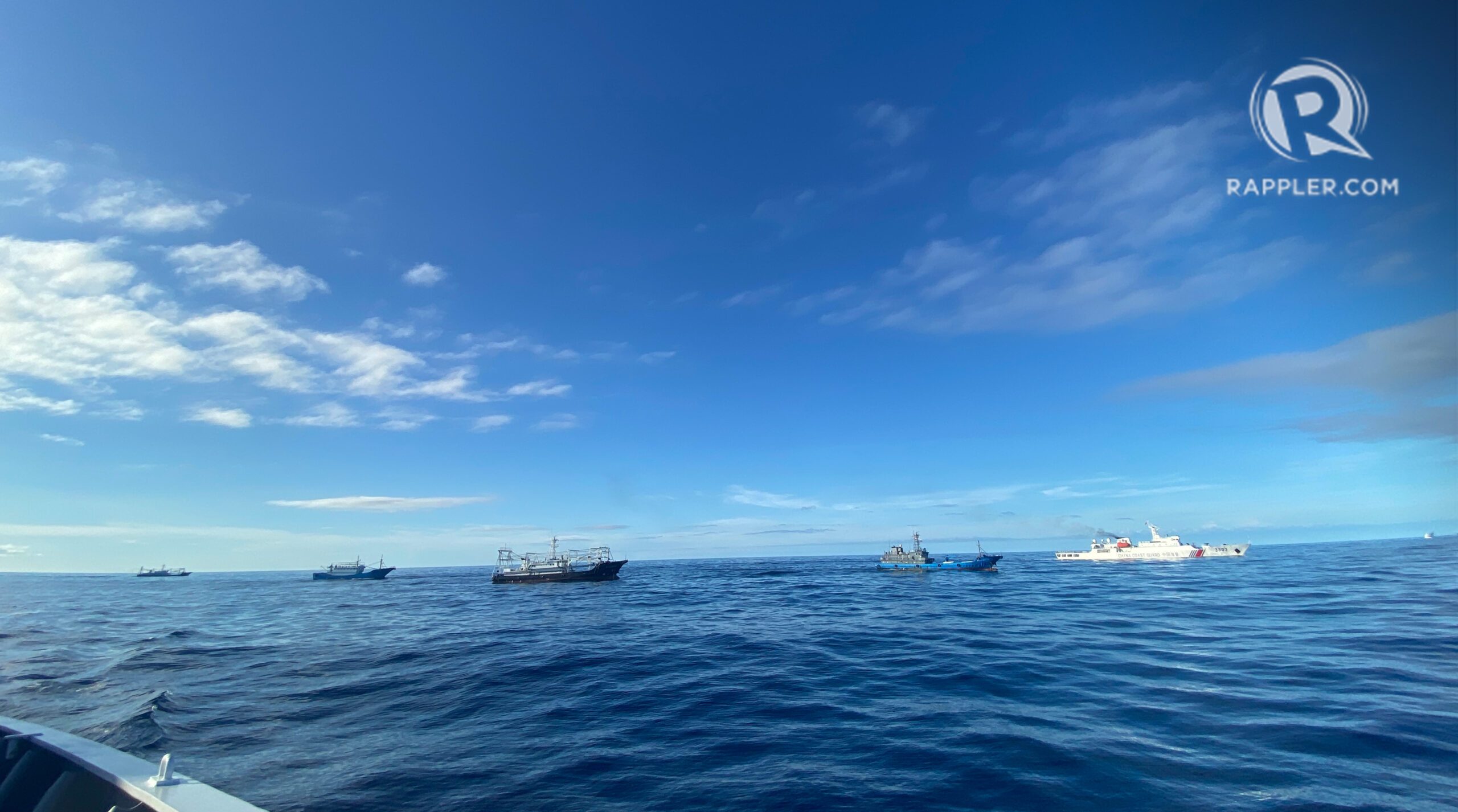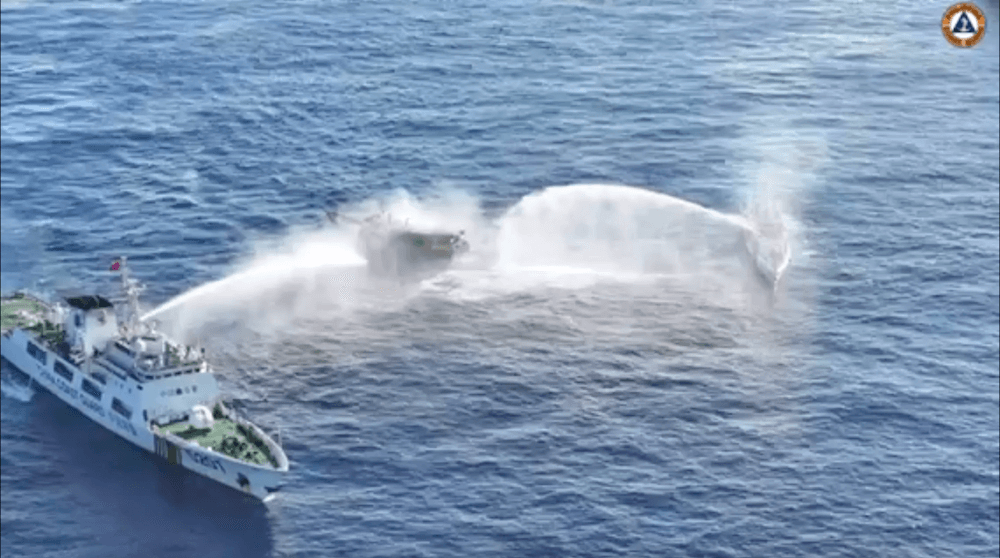SUMMARY
This is AI generated summarization, which may have errors. For context, always refer to the full article.

It was with the warmth of familiarity that US Secretary of State Antony Blinken, fresh off visits to Vienna and Seoul, affirmed progress in Philippine-US bilateral ties at his third stop in Manila.
“I think Ricky [Enrique Manalo] said it very well: We’ve been in hyperdrive, and that’s demonstrated by the results we’ve already achieved but also by our commitment to doing more, doing more together in the interests of both of our countries,” said Blinken, referring to his Filipino counterpart, Secretary Enrique Manalo.
“The alliance has never been stronger, but we not only have to sustain that, we have to continue to accelerate the momentum,” said Blinken on Tuesday, March 19, in a press briefing during his second visit to Manila under the presidency of Ferdinand Marcos Jr.
Manalo opened Tuesday’s press engagement by highlighting how ties have been on “hyperdrive over the past year or so” since Marcos took over.
“Engagements across issues, areas, and between and among government branches have never been better,” said Manalo.

To say relations are on “hyperdrive” is no exaggeration.
Blinken’s visit, after all, is only the latest in a long list of high-ranking American officials making their way to Manila, and Malacañang Palace.
The March 2024 visit was Blinken’s second (his first was on August 6, 2022), Vice President Kamala Harris went to Manila and Palawan in November 2022, US Defense Secretary Lloyd Austin paid a visit in January 2023, and Commerce Secretary Gina Raimondo led a Presidential Trade Mission just weeks before Blinken’s return.
“The back-to-back high-level visits from US officials indicate that Washington seeks to remain consistent in deepening and broadening the alliance with Manila in areas that go beyond defense, such as economic and tech cooperation, to better address emerging challenges,” said geopolitical analyst Don McLain Gill, a lecturer at the De La Salle University Department of International Studies.
While in Manila, Blinken also visited semiconductor company Amkor Technology and met with local entrepreneurs who previously joined exchange programs of his department. He ended his trip with a meeting and dinner at Malacañang Palace with Marcos.
Manila and Washington
The engagements come, in Manalo’s own words, at an “important juncture” in ties between Manila and its one-time colonizer.
Tensions in the South China Sea continue to rise, with no immediate signs of abating. Tense exchanges between China, which claims practically the entire sea, and Manila, in areas within the Philippines’ exclusive economic zone, have become almost routine. Heated confrontations have also spilled over onto public diplomacy, with spokespersons exchanging harsh words over each side’s actions in those waters.
Then there are growing concerns over Taiwan, and whether China would resort to violence to realize its dream of “reunification.” Marcos himself has said that it would be “very hard to imagine a scenario where the Philippines will not somehow get involved” should conflict erupt in the Taiwan Strait.
Washington has been clear in its stand, as China becomes more and more aggressive in claiming most of the South China Sea, despite the 2016 Arbitral Award.

“We have a shared concern about the PRC [People’s Republic of China]’s actions that threaten our common vision for a free, open Indo-Pacific, including in the South China Sea and in the Philippines exclusive economic zone. Repeated violations of international law and the rights of the Philippines – water cannons, blocking maneuvers, close shadowing, other dangerous operations – these waterways are critical to the Philippines, to its security, to its economy, but they’re also critical to the interests of the region, the United States, and the world,” said Blinken.
“It’s why we stand with the Philippines and stand by our ironclad defense commitments, including under the Mutual Defense Treaty (MDT). Article IV extends to armed attacks on the Filipino armed forces, public vessels, aircraft – including those of its coast guard – anywhere in the South China Sea. Most important is [that] we stand together in our determination to uphold international law – for the Philippines, for everyone else – against any provocative actions,” the American diplomat added.
Yet when pushed on what would actually trigger the MDT, a treaty Beijing called a “vestige of the Cold War,” neither Blinken nor Manalo answered the question head on.
The Mutual Defense Treaty
The MDT, signed in 1951, serves as the foundation of ties between the Philippines and the United States, its colonizer of over five decades.
Article IV states: “Each Party recognizes that an armed attack in the Pacific area on either of the Parties would be dangerous to its own peace and safety and declares that it would act to meet the common dangers in accordance with its constitutional processes.”
China’s actions in the West Philippine Sea are what experts describe as “gray zone tactics” – actions that are provocative and often dangerous, but an inch shy of an “armed attack.”
In Ayungin Shoal near Palawan and Bajo de Masinloc off the coast of Zambales, the China Coast Guard, with the support of the Chinese Maritime Militia, shadow and block Philippine ships – either the Philippine Coast Guard (PCG) or military-contracted boats – from bringing supplies and troops to the BRP Sierra Madre or bringing aide to fishermen trying to access Bajo de Masinloc.
It’s perilous out at sea – missions to the West Philippine Sea have resulted in collisions and allisions. The last time China whipped out its coast guard’s water cannons, the pressure was strong enough to shatter the wind shield of the much-smaller Unaizah May 4, injuring four Navy personnel.
“With regard to the Mutual Defense Treaty, I’ll simply repeat what I said. We stand behind it. We have an ironclad commitment to it and to the Philippines, and Article IV of that treaty extends to any armed attacks on Filipino armed forces, on public vessels, on aircraft, and that would include its coast guard. And that would also be anywhere in the South China Sea. So we’ve been very clear about that, very consistent about that,” said Blinken.

Gill said neither the US nor the Philippines can be begrudged for refusing to go into specifics – at least publicly.
“This terminological ambiguity must also be understood in terms of the concerns both Manila and Washington may have upon explicitly defining what an armed attack means,” explained Gill.
Think of it this way: if the two sides offer a strict definition and China happens to cross that line, it’d be a bigger mess if the Philippine-US alliance is unable to respond.
“This will tarnish the image of the alliance and provide China with more opportunities to exploit loopholes for its narrowly driven ambitions. Therefore, such caution from the US and the Philippines is pragmatic,” added Gill.
Diplomacy, said both diplomats, is key amid rising tensions and even in the face of danger out at sea. “I have to repeat that the Philippines has always maintained the policy of addressing any disputes and managing them through diplomatic means and through peaceful means, and we are still committed to that,” said Manalo.
‘Poking the bear’
Marcos himself was evasive, too, when asked by Bloomberg Asia to gauge “how far [the US is] prepared to go” in case of conflict in the South China Sea.
“We would like to take a step back from that question, that is precisely what we want to avoid. We want to do everything we possibly can together with our partners and our allies, to avoid that situation. This is not poking the bear, as it were. We are trying to do quite the opposite,” said Marcos in the interview, taped shortly before he met with Blinken.
Both the Philippines and the United States were quick to say that alliances – including the budding threesome with Japan – exist in “service of something” and not “against anyone or anything,” in Blinken’s words.
Manalo said increased defense ties with the US will help the Philippines’ “defense and security interests as well as operations on humanitarian issues” and are “not aimed at any third country.”
That’s not how Beijing sees it.
Responding to Blinken’s renewal of security commitments of the US to the Philippines and his “shared concern” over China’s actions at sea, Chinese foreign ministry spokesperson Lin Jian told a press conference on March 19: “The US is not a party to the South China Sea issue and has no right to interfere in the maritime issues between China and the Philippines.”
“The military cooperation between the US and the Philippines should not undermine China’s sovereignty and maritime rights and interests in the South China Sea, nor should it be used to support the illegal claims of the Philippines,” he added.
Lin and Beijing will certainly be keeping even closer watch in the West Philippine Sea – and they will certainly not like what they’ll see in the coming months.
Maritime Cooperative Activities (MCA) – joint air and sea patrols between the United States Indo-Pacific Command and the Armed Forces of the Philippines – are almost certain to continue in 2024. Three iterations of the joint patrols have taken place since late 2023.
Balikatan, a yearly joint military exercise primarily between the US and Philippines, will be happening in key areas – Batanes, a stone’s throw away from Taiwan; Palawan, close to Ayungin Shoal; and Marcos’ hometown of Laoag in Ilocos Norte.
Recently, assistant secretaries from the Philippines and US met in Manila to “discuss the logistics capabilities in Enhanced Defense Cooperation Agreement sites.” The Philippines defense department’s Assistant Secretary for Logistics, Acquisition, & Self-Reliant Defense Posture Joselito Ramos said the “sites could accommodate a large number of logistical assets” for Balikatan.
To Gill, Blinken’s visit solidifies two other things, aside from Washington’s efforts to be consistent in its relations with the Philippines. “Amidst the tumultuous geopolitical shifts in Europe and the Middle East, Washington remains committed to strengthening its position in the Indo-Pacific and working closely with key allies like the Philippines,” he said.
The visit also acts as a very high-profile way to prepare for the expansion of Philippine-US ties to include Japan – a key ally of Washington DC and a close partner of Manila, said Gill.
Of the US’ highest officials, it’s the one on top who has yet to make his way to the shores of Manila: Biden.
Marcos has met US President Joe Biden in formal, bilateral settings twice – first in September 2022 on the sidelines of the United Nations General Assembly, then again in May 2023 for a White House visit.
The Philippine president, chief executive of the US’ “oldest ally in the Indo-Pacific,” will be visiting the White House again soon, this time for the first-ever US-Japan-Philippines leaders’ summit to be hosted by Biden in April 2024 and for another bilateral meeting with the US president. – Rappler.com
Add a comment
How does this make you feel?
![[In This Economy] Marcos’ POGO ban is popular, but will it work?](https://www.rappler.com/tachyon/2024/07/thought-leaders-marcos-pogo-ban.jpg?resize=257%2C257&crop=255px%2C0px%2C720px%2C720px)
![[Rappler Investigates] POGOs no-go as Typhoon Carina exits](https://www.rappler.com/tachyon/2024/07/newsletter-graphics-carina-pogo.jpg?resize=257%2C257&crop=424px%2C0px%2C1080px%2C1080px)





![[Just Saying] SONA 2024: Some disturbing points](https://www.rappler.com/tachyon/2024/07/TL-marcos-sona-points-july-23-2024.jpg?resize=257%2C257&crop=335px%2C0px%2C720px%2C720px)

There are no comments yet. Add your comment to start the conversation.